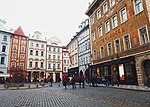Church of Saint Michael the Archangel in Prague
Baroque architecture in PragueBaroque church buildings in the Czech RepublicChurches in Prague 1Gothic architecture in the Czech Republic

Church of Saint Michael the Archangel is a church situated in Prague, Czech Republic. It was built in Romanesque and Gothic style and later rebuilt in Baroque style. The priest and church reformer Jan Hus celebrated masses in the church. The church and adjacent monastery were disestablished during the reforms of the Emperor Joseph II in the 18th century. Later, the buildings served as a warehouse. In the crypt, there are buried rectors of the Prague's University.
Excerpt from the Wikipedia article Church of Saint Michael the Archangel in Prague (License: CC BY-SA 3.0, Authors, Images).Church of Saint Michael the Archangel in Prague
Malé náměstí, Prague Old Town
Geographical coordinates (GPS) Address External links Nearby Places Show on map
Geographical coordinates (GPS)
| Latitude | Longitude |
|---|---|
| N 50.086388888889 ° | E 14.420277777778 ° |
Address
svatý Michael archanděl
Malé náměstí
116 65 Prague, Old Town
Prague, Czechia
Open on Google Maps










